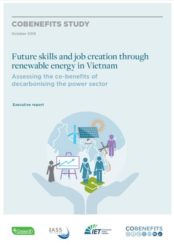 The study analyses the employment impacts of various scenarios for expanding electricity generation in Vietnam’s power sector. Four scenarios are analysed for the future development of the power sector in Vietnam: The Ministry of Industry and Trade (MOIT) revised seventh Power Development Plan; Danish Energy Agency Stated Policy (DEA Stated Policies); Asian Development Bank “Pathways to low-carbon development for Vietnam” low-carbon scenario (ADB Low-Carbon); and the Green Innovation and Development Centre (GreenID) Base and Renewable Energy (Base & Renew En) scenario. This report presents the resulting employment effects, presuming that the electricity sector focuses on all power generation technologies outlined in the government’s official power sector plan. It also provides an initial assessment of the skill requirements, attainment levels and technical training required for Vietnam’s present power sector plans and future low-carbon power sector ambitions. The four scenarios consider timelines consistent with MOIT’s reporting of the PDP 7 (rev) scenario, which is between the years 2015 and 2030.
The study analyses the employment impacts of various scenarios for expanding electricity generation in Vietnam’s power sector. Four scenarios are analysed for the future development of the power sector in Vietnam: The Ministry of Industry and Trade (MOIT) revised seventh Power Development Plan; Danish Energy Agency Stated Policy (DEA Stated Policies); Asian Development Bank “Pathways to low-carbon development for Vietnam” low-carbon scenario (ADB Low-Carbon); and the Green Innovation and Development Centre (GreenID) Base and Renewable Energy (Base & Renew En) scenario. This report presents the resulting employment effects, presuming that the electricity sector focuses on all power generation technologies outlined in the government’s official power sector plan. It also provides an initial assessment of the skill requirements, attainment levels and technical training required for Vietnam’s present power sector plans and future low-carbon power sector ambitions. The four scenarios consider timelines consistent with MOIT’s reporting of the PDP 7 (rev) scenario, which is between the years 2015 and 2030.
Download:
- Executive report
- Executive report — Vietnamese
- Executive summary
Key policy opportunities:
Policy opportunity 1: With the decision by the Vietnamese Government to increase the share of renewables from 6 % to 10.7 % in the current power sector plan (PDP 7 rev), the government paved the way to creating 315,000 job-years through the power sector by the year 2030. With renewables creating twice as many jobs as the fossil-fuel sector per average installed MW, the government can further boost employment by adopting a more ambitious low-carbon power sector plan.
Policy opportunity 2: For wind and solar, around 25 % of jobs created are for high-skilled workers. The tendency for high-skilled workers in the power sector is expected to further increase over the next decade in Vietnam. Therefore, the training capacities at universities and technical schools need to be reconciled with this development, in order to create employment in Vietnam and to meet the expected demand in the country.
Policy opportunity 3: The government can actively manage a just transition to lowcarbon energy sources by redeveloping vocational training curricula and university programmes towards the new energy world of renewables while supporting affected workers and communities domiciled in the coal-power-generating regions of the country, such as the Mekong Delta.
Year of publication: 2019
Editors: Ayodeji Okunlola, Laura Nagel, Sebastian Helgenberger, Nguy Thi Khanh, Nguyen Thi
Mai Dung and Sarah Kovac — IASS Potsdam, GreenID and UfU
Technical implementation: Klaus Sauerborn, Pham Ngoc Toan, Nguyen Thi Hoang Nguyen,
Đào Quang Vinh — Institute of Labour Science and Social Affairs, Vietnam
Suggested citation: IASS/Green ID. Future skills and job creation through renewable energy in Vietnam. Assessing the co-benefits of decarbonising the power sector. Potsdam/Hannoi: IASS/Green ID, 2019.
DOI: 10.2312/iass.2019/024
This study is part of a 2019 series of two studies assessing the co-benefits of decarbonising the power sector in Vietnam. Edited by IASS, GreenID and UfU:

